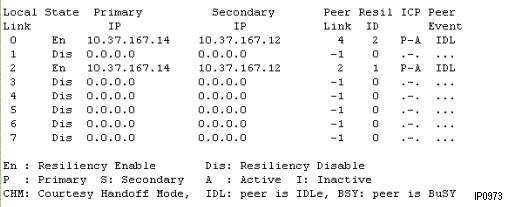
None.
Enter this command to show the resiliency status of a T1/E1 Combo MMC (PN 50005160) card.
Local Link: Link number (0 to 7) on the local ICP. The local ICP is the ICP that you are currently logged into.
State: "En" means resiliency is enabled (programmed) on the local ICP; "Dis" means disabled (not programmed) on the local ICP.
Primary IP: IP address of the primary ICP
Secondary IP: IP address of the secondary ICP
Peer Link: Link number (0 to 7) of the resilient link that is programmed on the remote, peer ICP. A value of -1 means the local ICP is in the process of getting the resilient link number from the peer ICP. The local ICP must get the resilient link number of the peer ICP before the local ICP can communicate with the peer ICP.
ResilID: Link identifier (1 to 4) of the resilient link on the local ICP. 0 means link is not used. The link identifier must be unique and must match the identifier that is entered for the resilient link on the other (remote) ICP. Typically, the link ID should be programmed to match the controller module slot number of the resilient T1/E1 Combo MMC.
ICP:
Identifies the local ICP as the primary or secondary
ICP for the resilient link and identifies whether or
not the resilient link is active or inactive:
"P - I" = Primary ICP is not controlling the
resilient link
"P - A" = Primary ICP is controlling the resilient
link
"S - I" = Secondary ICP is not controlling
the resilient link
"S - A" = Secondary ICP is controlling the
resilient link
Peer
Event: Displays the status of the link on the resilient peer ICP:
"IDL" = Link is idle
"BSY" = Link is busy
"CHM" = Link is in courtesy
handoff mode
Note: Refer to the Resiliency Guide for instructions on how to install, configure, troubleshoot, and maintain T1/E1 trunk resiliency.

